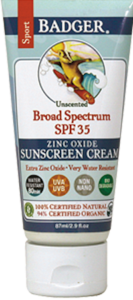South Florida’s coral reef is one of the longest and most heavily visited in the world. Excited crowds head out to this gorgeous, but sensitive, living structure in increasingly greater numbers. How lucky we are to have such a breathtaking natural area on our doorstep. But like so many things, good fortune is tinged with hidden responsibilities. Recent studies indicate that commonly used sunscreen ingredients can harm coral reefs. What follows is a brief summary of the current science on coral impacts from sunscreens and what alternatives exist to keep both the reef and our skin safe. Use Reef Safe Sunscreens.
First, a little chemistry. One commonly used ingredient in particular is harmful to coral reefs. This chemical is oxybenzone (BP-3), which is used in more than 3,500 sunscreen products worldwide. There are several other problem ingredients, but BP-3 is the most common. Scientists studying the impacts of BP-3 on corals have found that this active ingredient can cause bleaching, damage DNA and result in hormone imbalances. Scientists have found that this chemical has impacts on developing juvenile corals. Their studies documented young corals encasing themselves in their own skeleton and dying. In hard corals this chemical can cause coral to develop viruses. Once they become infected, their life-giving algae is expelled from the coral, resulting in bleaching. These responses can be triggered by very small amounts of this chemical. How small? Imagine one drop of water in six Olympic-sized swimming pools; that is enough chemical to cause some damaging effects to these animals. Thankfully, we can play a big part in the solution.
- One of the first things we can do is cover our skin. Rash guards, scuba suits and hats are non-chemical ways to protect oneself from the sun.
- Another thing we can do to help both corals and ourselves is to apply sunscreen at least 15 minutes prior to getting in the water. Doing so will allow your skin to absorb the sunscreen, making it last longer and less likely to wash off in the water.
- Another step is to use “reef safe” sunscreen. But be aware that the phrase “reef safe” doesn’t necessarily mean what it says. There are no tests or certifications for this quality. You must look at ingredient lists to make sure reef-damaging substances aren’t included. In general, look for brands that use mineral ingredients such as titanium dioxide and zinc oxide instead of chemical ones. Our coral reefs face a lot of challenges.
 Badger Sport Sunscreen Cream 2.9 ounce (87ml)
Badger Sport Sunscreen Cream 2.9 ounce (87ml)
Raw Elements Eco Form Sunscreen, SPF 30 Plus, 3 Fluid Ounce
Thankfully, there are a lot of actions we can take that can make a big difference in our oceans. Being mindful about sunscreen is just one thing we can do to help keep our corals healthy and beautiful for generations to come. Want to see this beautiful reef? Don your rash guard, apply your reef safe sunscreen early and come join us in the state parks.
Visit floridastateparks.org to plan your visit. Chris Lamond is a park ranger at John Pennekamp Coral Reef State Park.
